
Introduction
Recruitment & Selection: definitions and practical application
Recruiting Talent in Corporate HR
Sourcing and targeting strategies
Building a recruitment portfolio
Selection Strategies in Corporate HR
Methods for assessing and hiring the right fit
Utilizing internal & external networks
Conclusion
Talent is essential to any organization. Unfortunately, organizations can get stuck in a rut without talented people and fail to innovate, create, or move forward. This is why any organization must realize its talent through effective recruitment & selection techniques. Corporate Human Resources (HR) plays a significant role in fulfilling this task. This article explores the strategies and techniques for sourcing, vetting, and hiring the best talent in Corporate HR.
Recruitment & Selection: Definitions and Practical Application
Recruitment and Selection are finding, developing, and acquiring the talent needed to fill an organization’s workforce gaps. These processes are distinct from one another but work together in harmony. Recruitment is the first step in the process and is the act of searching for and seeking out potential candidates for a position. Selection is the step that follows and is the process of evaluating the candidates against pre-defined criteria to determine who should ultimately be hired.
In a practical setting, recruitment and Selection in Corporate HR involve using advanced tactics, tools, and technology. For example, targeting specific communities and utilizing modern digital marketing tools such as LinkedIn or job boards are valuable methods of sourcing talent that might have otherwise gone unnoticed. Additionally, having well-crafted job descriptions and effective interviewing techniques are integral to getting the right person for the job.
Related Course: Digital Marketing Free Course
Recruiting Talent in Corporate HR
The recruitment process in Corporate HR should focus on sourcing and targeting the right people. Sourcing methods can range from traditional methods, such as job boards or social media, to unorthodox methods, such as employee referral programs or targeted recruiting tactics. Companies should also focus on targeted marketing with an understanding of the local job market and culture. This will help them find better-suited candidates for the positions.
HR professionals need to take the initiative and build a recruitment portfolio. This should include job descriptions and titles, skills assessments, resumes, and interview evaluation forms. Having such a portfolio will help ensure a more productive recruitment process.
Selection Strategies in Corporate HR
Once suitable candidates have been identified, the selection process can commence. First, corporate HR professionals must develop strategies to assess and hire the right fit for the position. This can involve determining the critical competencies required for a job and evaluating the candidate’s knowledge, skills, and experience.
Moreover, HR professionals should consider using internal and external networks during Selection. Internal networks involve using internal stakeholders such as supervisors, HR staff, and other members of the organization to make an informed decision about the candidate. External networks include utilizing objective third parties such as recruiters or industry experts to provide insight and make an informed decision on behalf of the organization.
Realizing talent is essential for any organization looking to remain competitive in the marketplace. This article has explored some strategies and techniques that Corporate HR professionals can use to source, vet, and hire the right people. This includes using digital and targeted marketing tools to source potential candidates, building a recruitment portfolio, and utilizing internal and external networks during the selection process. It is also important to remember that recruitment and Selection is a complex process, and having the right skills and practices will go a long way toward finding the right fit for the job.
The best way to recognize true talent is to seek it actively and evaluate it objectively.
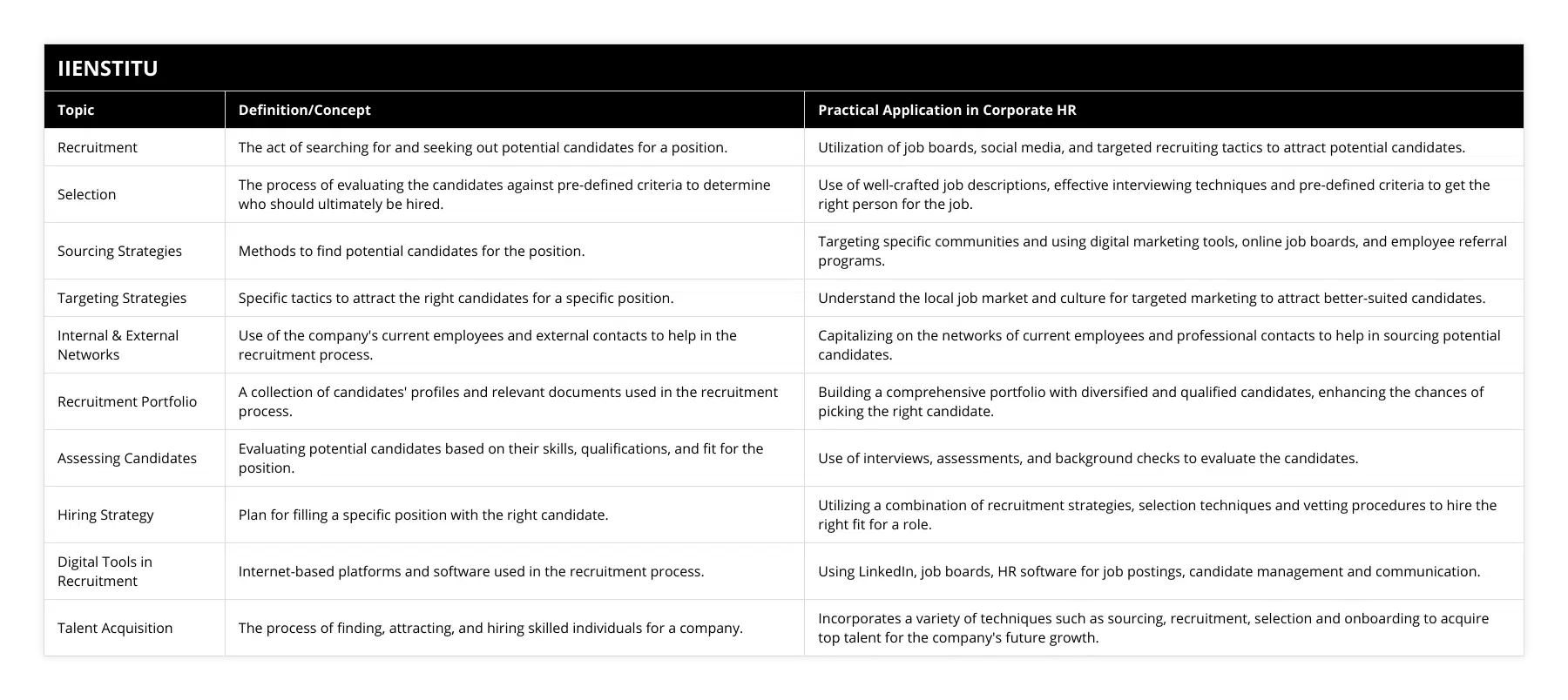
Frequently Asked Questions
How do corporate HR processes help in identifying and realizing talent in an organization?
The Human Resources (HR) organization is a critical business component. It is responsible for several functions that enable an organization to leverage and realize the potential of its workforce. One such function is the development of effective corporate HR processes and procedures that facilitate identifying and recognizing talent in an organization.
The primary goal of any corporate HR process is to ensure that the recruitment, assessment, and selection of personnel are conducted objectively and systematically to maximize the talent pool within the organization. This is done by creating a process that assesses the qualifications and experience of job seekers against predefined job criteria; ensuring that the recruitment and selection phases are carried out in an equitable manner that adheres to best practices in HR management; and providing guidance and support to line managers in choosing the best candidates for the job based on qualifications, merits, and competencies.
In addition to recruitment and selection, corporate HR processes help ensure that talent within an organization can be nurtured and developed over time. This includes initiatives such as implementing performance management plans which allow the organization to monitor and assess performance over time to ensure that employees are progressing in their development and that potential is realized. Other initiatives, such as online learning systems and mentoring programs, also help to develop existing skills further. In contrast, professional development initiatives such as secondment opportunities and external training courses help to develop existing potential further.
Ultimately, a well-crafted HR process can help the organization identify and realize talent. This includes the effective management of recruitment, selection, and performance processes, which can help identify and nurture talent, as well as initiatives that help employees develop new skills and reach their full potential. By implementing these strategies, companies can reap the rewards of an engaged and committed workforce and create an environment that attracts and retains top talent.
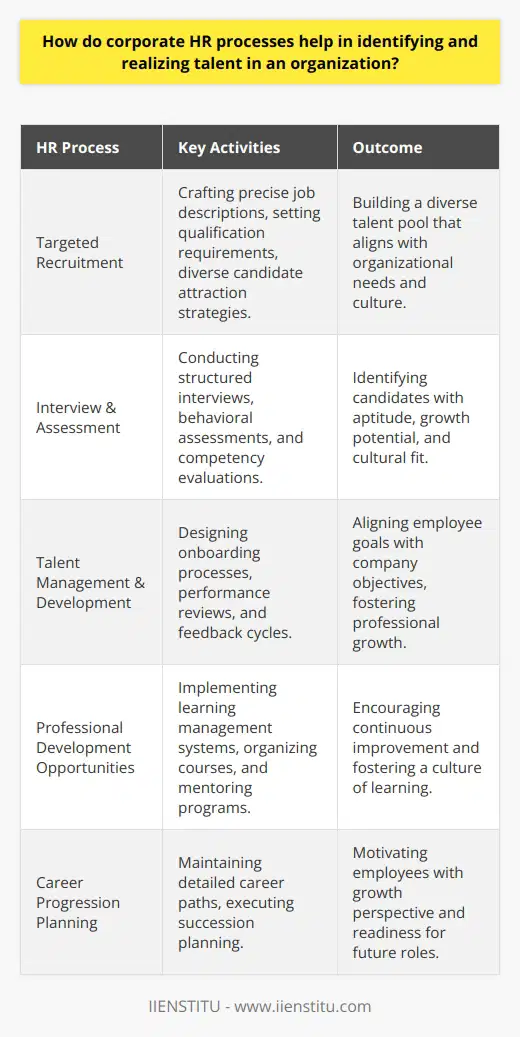
What are the key considerations in successful recruitment and selection procedures?
Recruitment and selection are critical to the success of any organization. The choice of personnel based on the skill sets, qualifications, and experience required for a specific job is essential to an organization's future. Effective recruitment and selection processes allow businesses to optimize resources, reduce costs, and improve performance.
Effective recruitment and selection procedures require significant planning and thought. One of the critical considerations is the need to develop job profiles and specifications, including job responsibilities, specific skills and qualifications needed, and job-related competencies. These job profiles and specifications should provide potential candidates with an understanding of the job requirements and how they will be evaluated.
In addition to the job profiles and specifications, developing a recruitment strategy is essential. A recruitment strategy should outline the process for attracting and selecting suitable candidates and the best methods for evaluating their suitability. In most cases, one or more methods are used: advertising, headhunting, employee referral, recruitment agencies, or job fairs.
Another critical consideration in successful recruitment and selection is the need to design and implement a selection procedure. Selection procedures should include assessments, tests, interviews, and reference checks. Evaluations and tests can help employers identify the competencies and skills of the candidates. Interviews allow employers to evaluate a candidate's suitability further. Reference checks enable employers to verify the information given by a candidate.
The selection process should be unbiased and free from any conflict of interest. This can be achieved by providing clear communication between recruiters and managers to ensure consistency of approach and by standardizing criteria to assess all candidates on the same level. Fairness, transparency, and texture must be observed for recruitment and selection to be successful.
Finally, and perhaps most importantly, effective recruitment and selection should include adequate feedback and communication with unsuccessful applicants. Clear communication between the organization and applicants is essential for successful talent management and ensuring that the organization remains an attractive employer.
In conclusion, recruitment and selection processes are essential to the long-term success of any organization. Effective recruitment and selection procedures require a clear definition of job profiles, specifications, and strategies. They should also include the use of appropriate selection methods and assessments, free from bias and conflict of interest. Finally, they should consist of comprehensive communication and feedback with unsuccessful applicants. By following these considerations, organizations can optimize resources, reduce costs, and improve performance.

What are the benefits of effective recruitment and selection to the overall organizational success?
Recruiting and selecting employees is critical to the success of any organization. Effective recruitment and selection can bring numerous benefits to the organization, from improved performance and productivity to increased employee morale and retention rates. This article will explore the advantages of effective recruitment and selection to the overall success of an organization.
One of the key benefits of effective recruitment and selection is that an organization can source high-quality talent. This means that employees are more likely to be engaged, motivated, and productive, leading to improved performance. By having access to a larger pool of candidates, employers can take their time to find the most suitable employees for the roles, who will be more likely to contribute to the organization's growth and success.
Effective recruitment and selection can also provide access to a more diverse workforce. Diversity in the workplace is essential for organizations to be successful, as it brings different perspectives and ideas. A more diverse workforce can also improve creativity and productivity in the workplace, as each employee gets an other skill set to the team.
Furthermore, effective recruitment and selection can improve employee morale and retention. If a company sources quality candidates and provides them with a pleasant working environment, they are more likely to stay in their roles for extended periods. Companies that invest in recruitment and selection can also show existing and prospective employees that they value the contribution of all employees, which can lead to improved morale and loyalty to the organization.
In conclusion, effective recruitment and selection are beneficial for organizations, as they can lead to improved performance and productivity, greater diversity in the workforce, and improved morale and retention. Companies that invest in and prioritize recruitment and selection can strengthen their team, boost productivity, and increase their chances of success.
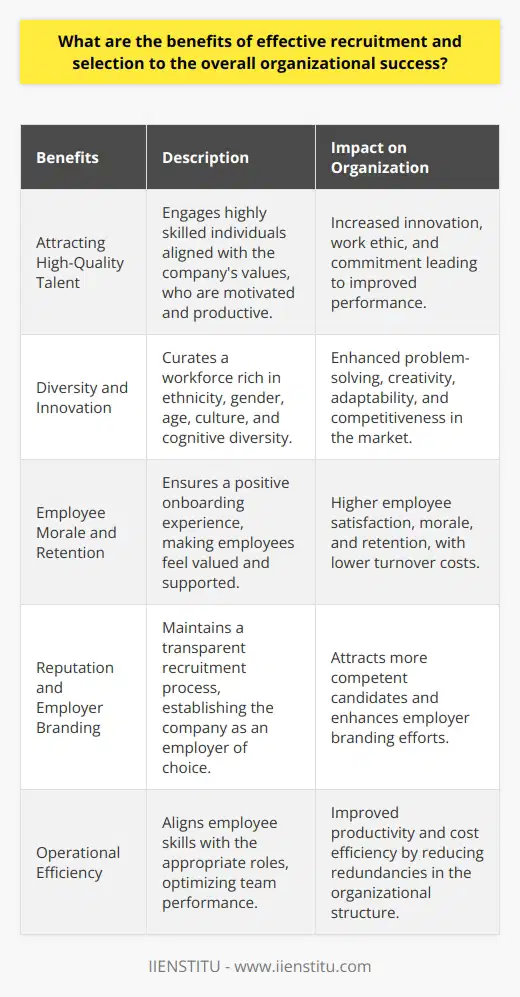
What is the role of talent management in the recruitment and selection process?
Role of Talent Management
Talent management plays a critical part in the recruitment and selection process, impacting both organizational success and employee satisfaction. It is crucial to understand the main components of talent management, such as talent identification, acquisition, development, and retention, to improve the recruitment process.
Talent Identification and Acquisition
The first stage of talent management involves identifying the required skills and competencies for each job position. By understanding these requirements, recruiters can design accurate job descriptions and select the most suitable candidates. Additionally, recruiters can employ various strategies to attract potential candidates with the desired competencies, such as targeted advertisements, networking, and campus recruitment.
Candidate Evaluation
During the selection process, talent management helps in designing appropriate evaluation processes to ensure the potential candidates match the required skills, abilities, and cultural fit for the organization. Recruiters may use various assessment tools, such as interviews, skill tests, and psychometric evaluations to gain insights into candidates' aptitudes and behavioral traits. This process helps to avoid recruitment errors and ensures the right fit between the candidate and the job role.
Talent Development
After hiring new employees, organizations should invest in their growth and development for continuous improvement. Talent management plays a central role in creating and implementing personalized training programs, career development plans, and mentoring opportunities. Providing such development opportunities contributes to employee satisfaction, fosters loyalty, and improves employee job performance.
Talent Retention
Retaining high-performing employees is essential for organizational success, and one of the crucial responsibilities of talent management is facilitating a supportive work environment that allows for employee retention. By offering competitive compensation packages, recognizing outstanding performances, and formulating promotion and succession plans, organizations can increase the commitment and engagement of their employees.
In conclusion, talent management is essential for enhancing the recruitment and selection process, leading to improved employee satisfaction and increased productivity. Engaging in thoughtful talent identification, candidate evaluation, talent development, and retention practices ensures that organizations attract, develop, and maintain an exceptional workforce that can contribute effectively to organizational success.

How does a comprehensive talent acquisition strategy contribute to an organization's human resources goals?
Aligning Talent Acquisition with Human Resources Goals
A comprehensive talent acquisition strategy plays a crucial role in fulfilling an organization's human resources (HR) goals. By ensuring a systematic approach to identifying, attracting, and retaining top talent, the organization can successfully fulfill its skills requirements and achieve its strategic objectives.
Role of Talent Acquisition in Workforce Planning
Talent acquisition is not merely a process of filling open positions; it involves understanding the organization's current and future skills requirements to ensure a robust talent pipeline. By aligning talent acquisition with workforce planning, HR professionals can proactively identify skills gaps, anticipate staffing needs, and develop strategies to fulfill those needs, contributing to the long-term success of the organization.
Enhancing Employer Brand and Attraction
A comprehensive talent acquisition strategy encompasses effective employer branding, which plays a vital role in attracting and retaining top talent. Showcasing an organization's values, culture, and career opportunities helps create a favorable image in the job market, encouraging highly-skilled professionals to consider the organization as an employer of choice. This, in turn, contributes to the HR goals of having a strong workforce and low turnover.
Engaging Recruitment Channels and Technology
Effective talent acquisition relies on leveraging diverse recruitment channels and technology to cast a wider net in skills sourcing. By engaging with both active and passive talent pools, utilizing online job boards, social media, and referral networks, HR professionals can tap into a broad array of potential candidates. Moreover, implementing technology solutions such as applicant tracking systems (ATS) and data-driven insights facilitate an efficient recruitment process, optimizing the candidate pool and enhancing the quality of hires.
Promoting Diversity and Inclusion
A comprehensive talent acquisition strategy must prioritize diversity and inclusion, as diverse teams have been proven to drive innovation and profitability. By implementing recruitment practices that encourage diversity and building inclusive workplace cultures, organizations can ensure they attract diverse candidates who will contribute positively to the HR goals of a more engaged and high-performing workforce.
Mitigating Legal Risks
Finally, an effective talent acquisition strategy includes compliance with laws and regulations, which is essential to both protecting the organization from legal risks and ensuring a fair hiring process. By adopting objective, non-discriminatory practices, organizations can ensure that they avoid legal pitfalls while attracting the best possible talent.
In conclusion, a comprehensive talent acquisition strategy is a critical component in achieving an organization's human resources goals. By aligning recruiting efforts with workforce planning, enhancing employer branding, leveraging recruitment channels and technology, promoting diversity and inclusion, and adhering to legal compliance, organizations can attract and retain top talent, ensuring a robust and capable workforce capable of achieving their strategic objectives.
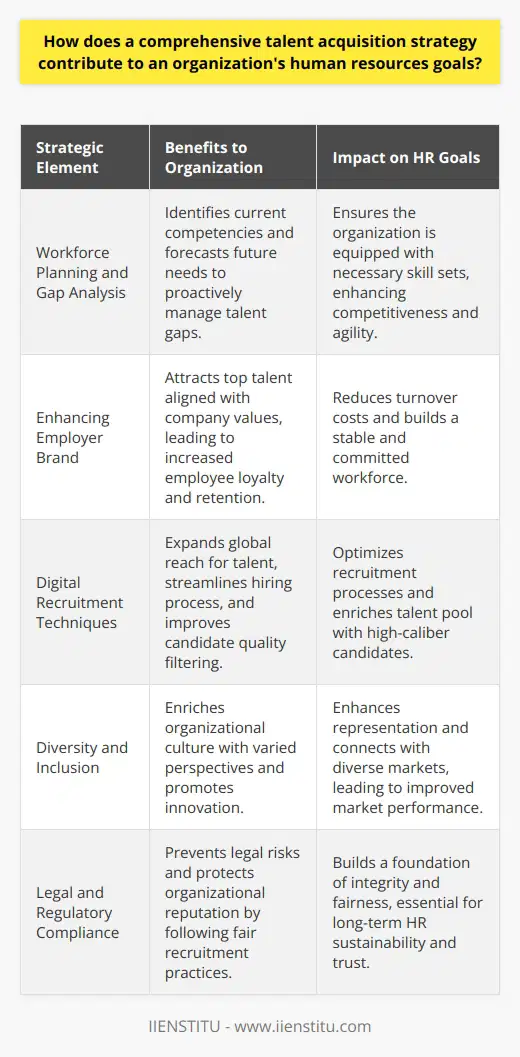
In what ways can effective talent acquisition strategies be integrated within the broader HR framework to ensure organizational success?
Incorporating Talent Acquisition Strategies within HR Framework
Effective talent acquisition strategies can be integrated within the broader human resources (HR) framework through various techniques to ensure organizational success. By aligning recruitment and selection processes with overall business goals, HR can create a unified approach to attract and retain the best employees.
Aligning Recruitment and Selection Processes
To begin, HR departments must understand the organizational objectives and required skills needed for each job vacancy. By doing this, HR can develop relevant job descriptions, qualifications, and competencies needed for successful candidates.
Creating a Competitive Employer Brand
Establishing a strong employer brand is crucial for attracting top talent. The HR team can build a positive employer image by promoting company culture, employee engagement, and providing competitive compensation and benefits packages.
Leveraging Technology and Data Analytics
Incorporating technology and data analytics into the recruitment process streamlines talent acquisition efforts. Utilizing HR software and applicant tracking systems enable efficient sourcing, screening, and interviewing of potential candidates. Data analytics can also help identify recruitment trends and improve decision-making in selecting ideal employees.
Fostering Employee Referral Program
An employee referral program can help integrate talent acquisition strategies within the HR framework. Encouraging employees to recommend potential candidates fosters a collaborative environment and helps identify suitable applicants from existing professionals' networks.
Investing in Continuous Learning & Development
After successful talent acquisition, continuous learning and development ensure employees remain competitive and relevant in their roles. By offering opportunities for professional development, HR supports employee growth, which can lead to increased job satisfaction and higher retention rates.
Cultivating a Diverse and Inclusive Workforce
Promoting workplace diversity and inclusion is central to building a successful organizational culture. HR departments should establish company-wide policies that support a diverse workforce, providing fair opportunities for candidates from different backgrounds.
In conclusion, integrating effective talent acquisition strategies within the broader HR framework can help organizations attract, select, and retain the best employees. By aligning recruitment processes with business goals, building a strong employer brand, leveraging technology, fostering referrals, investing in learning and development, and promoting diversity, companies can enhance their overall HR effectiveness and ensure organizational success.

What are the key components of an effective talent management strategy?
**Identification and Recruitment**
The first key component of an effective talent management strategy is the identification and recruitment of high potential talent. This involves understanding the organization's needs, leveraging data and analytics to identify skill gaps, and using targeted recruitment strategies to attract top talent from diverse sources. Additionally, implementing a robust onboarding process that emphasizes a successful integration of new hires into the organizational culture is crucial.
**Development and Retention**
Another critical component is the development and retention of existing talent. This entails offering continuous learning and development opportunities that align individual and organizational goals, with a focus on improving skills, competencies, and performance. The organization should provide resources for mentoring, coaching, and performance feedback, aiming to foster employee engagement and motivation. Additionally, creating an inclusive and supportive work environment that encourages innovation, collaboration, and growth helps to retain top talent.
**Succession Planning and Workforce Agility**
Preparation for future leadership roles and the ability to adapt to changing business landscapes are also essential aspects of an effective talent management strategy. Succession planning involves identifying potential leaders, providing role-based development programs, and giving exposure to various aspects of the organization. This ensures a continuous pipeline of leadership talent and reduces disruptions due to unexpected vacancies. Workforce agility enables an organization to respond to evolving market conditions or business challenges by reallocating talent, redefining roles, and redesigning processes as needed.
**Performance Management and Employee Engagement**
Talent management strategies should also incorporate performance management processes that align employee performance expectations and objectives with organizational goals. Implementing an ongoing performance feedback system that emphasizes open communication, goal-setting, and evaluation of progress helps to ensure employees remain engaged and results-driven. Fostering employee engagement is critical for retaining top talent, improving employee satisfaction, and boosting productivity. Offering recognition programs, encouraging work-life balance, and promoting employee wellness contribute to a positive work environment in which employees feel valued.
**Integration and Alignment**
A comprehensive talent management strategy must also incorporate integration and alignment with the organization's mission, values, and overall business strategy. This includes coherence between processes such as recruitment, performance management, and learning and development. An integrated approach ensures consistency, while alignment with organizational vision helps in achieving the desired outcomes and overall business success. This holistic approach also includes understanding and addressing external factors, such as the competitive landscape, industry trends, and changing talent expectations to ensure a sustainable talent pipeline.
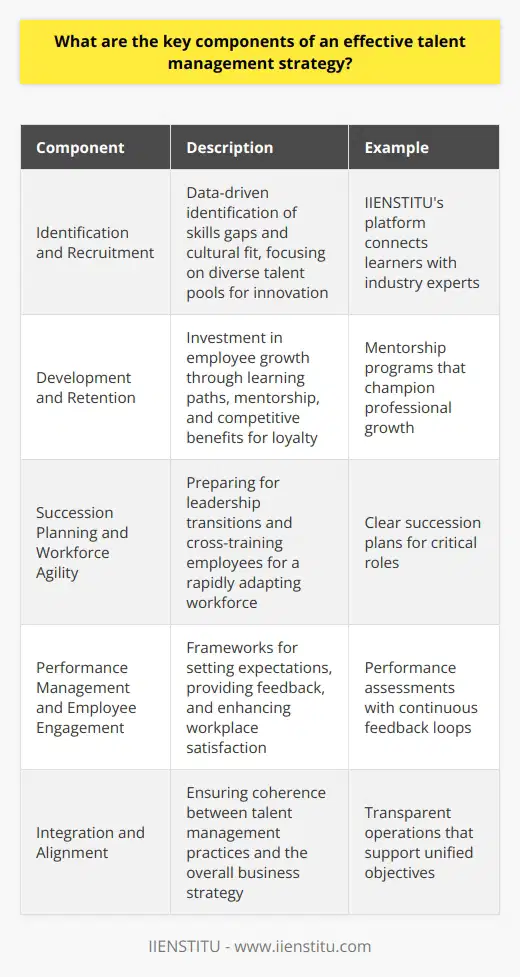
How can organizations ensure a seamless transition between talent acquisition and talent development?
Establishing a Talent Ecosystem
To ensure a seamless transition between talent acquisition and talent development, organizations should establish a comprehensive talent ecosystem that integrates both aspects. This involves implementing structured processes in recruitment, onboarding, training, and advancement, as well as leveraging technology and data analytics to make well-informed decisions.
Aligning Acquisition and Development Strategies
Organizations should begin by aligning their talent acquisition and development strategies to the overall business objectives. This will ensure that the organization attracts and retains individuals who have the right skills and fit the company culture. Furthermore, streamlined communication between the human resources department and strategic business units is essential to facilitate seamless talent management.
Efficient Onboarding Process
An efficient onboarding process is crucial to help new hires transition smoothly into their roles and the organizational culture. By providing clear expectations, resources, and required support, new employees can adapt quickly to their roles and become valuable contributors to the company. Additionally, assigning mentors or peers to new hires fosters an environment of learning and support.
Continuous Learning and Training
Organizations must prioritize continuous learning and development opportunities that cater to employees' diverse needs and interests. From skill-specific training programs to leadership workshops, employees should have access to resources that enable them to grow both personally and professionally. In turn, this will foster a culture of constant improvement and innovation within the organization.
Monitoring Progress and Providing Feedback
Monitoring employee progress allows organizations to identify areas that require further development or improvement. Regular performance appraisals and feedback sessions will help employees understand their strengths, areas for growth, and their impact on the organization. This continuous communication ensures that potential gaps in skills or knowledge are quickly addressed, benefiting both the employee and the organization.
Leveraging Technology and Data
Organizations should leverage technology and data analytics to track and monitor talent acquisition and development initiatives. By utilizing talent management software, companies can analyze workforce trends and measure the effectiveness of training programs. This data-driven approach enables organizations to make better-informed decisions and optimize their talent management strategies.
In conclusion, a comprehensive and integrated talent ecosystem is key to ensuring a seamless transition between talent acquisition and development. By aligning strategies, implementing efficient onboarding processes, prioritizing continuous learning, monitoring progress, and leveraging technology, organizations can foster an environment where employees can seamlessly grow and contribute to the company's success.
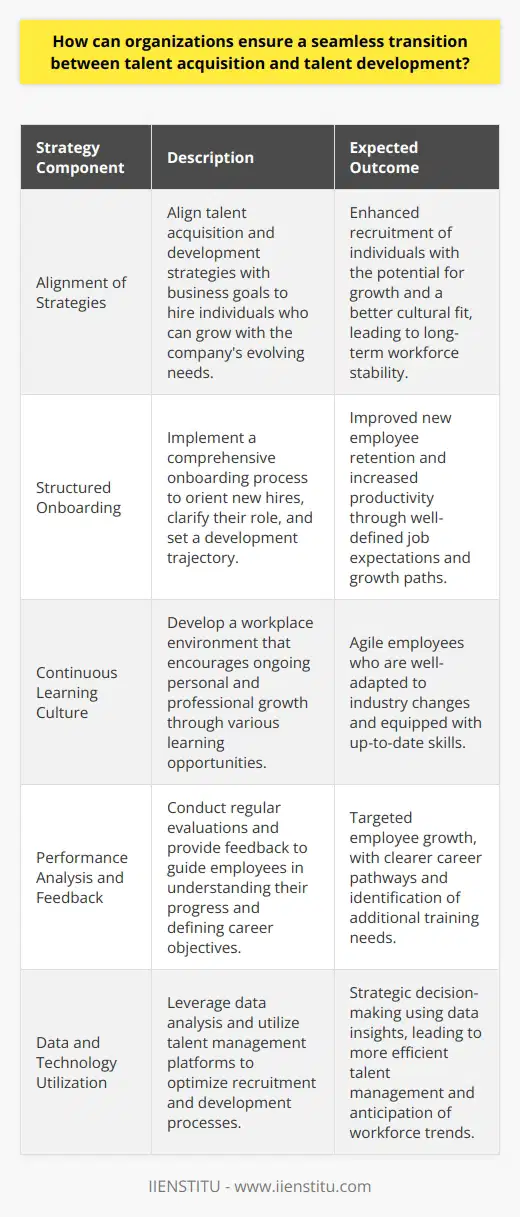
What role does organizational culture play in attracting and retaining top talent within the HR framework?
Role of Organizational Culture in Attraction and Retention
Organizational culture plays a crucial role in attracting and retaining top talent within the HR framework. A company's culture reflects its values, principles, and work environment, which ultimately impact employee engagement and performance.
Building a Strong Employer Brand
A positive organizational culture helps create a strong employer brand. This fosters a sense of pride among employees and attracts potential candidates who align with the company's values. A well-defined culture enables organizations to effectively articulate their mission and vision, positioning them as an employer of choice for top talent.
Enhancing Employee Satisfaction
Employee satisfaction is closely linked to an organization's culture. A supportive and inclusive environment promotes open communication, employee involvement, and opportunities for growth. In turn, employees are more likely to remain committed to their roles and demonstrate higher levels of engagement, contributing to talent retention.
Fostering Collaboration and Innovation
An effective organizational culture encourages collaboration and innovation. The cultivation of a collaborative, team-oriented environment fosters a sense of belonging among employees, making them more likely to stay with the company. Additionally, an environment that rewards innovation and supports risk-taking motivates high-performing employees to develop breakthrough ideas, which drives organizational success.
Reducing Turnover and Costs
A strong organizational culture positively influences employee retention, reducing costly turnover. High employee churn exposes organizations to significant direct and indirect costs, such as recruiting expenses, lost productivity, and the time required to train new employees. By nurturing a supportive organizational culture, companies can mitigate these costs by retaining top talent.
In conclusion, organizational culture serves as a powerful tool in attracting and retaining top talent within the HR framework. By building a strong employer brand, enhancing employee satisfaction, fostering collaboration and innovation, and reducing turnover, a healthy organizational culture ensures the long-term success of both the company and its employees.
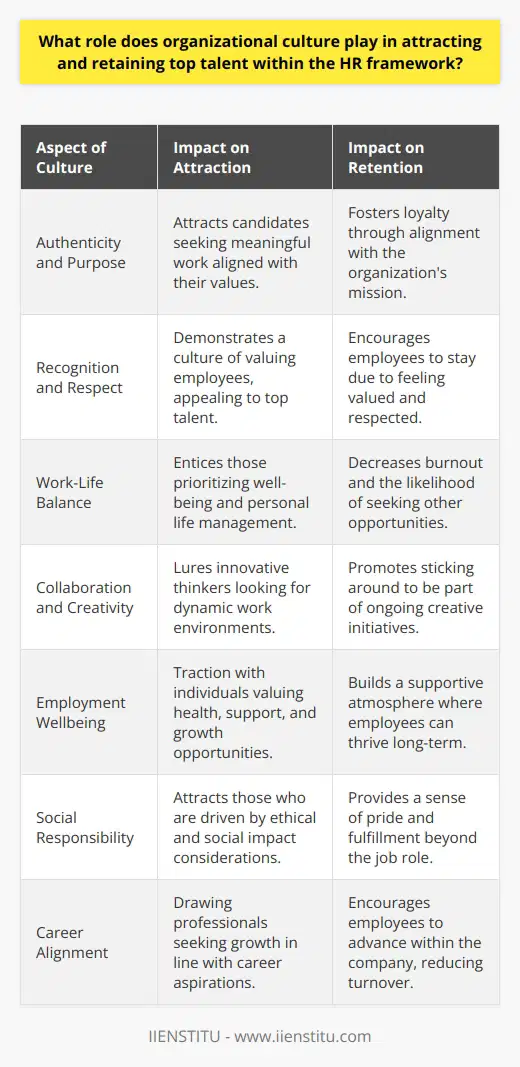
What is the role of talent analytics in the talent acquisition process?
Role of Talent Analytics in Talent Acquisition
Understanding Talent Analytics
Talent analytics plays a crucial role in the talent acquisition process as it harnesses the power of data and analytics to make strategic and objective decisions in hiring activities. It involves the systematic collection, analysis and interpretation of data about candidates, employees and the job market to optimize talent-related operations and support organizational goals.
Data-Driven Decision Making
By leveraging talent analytics in the talent acquisition process, organizations can make data-driven decisions and effectively measure the success of their recruitment strategies. This includes examining essential metrics such as time-to-fill, cost per hire, and applicant conversion rates, which can help identify areas of improvement for recruitment strategies and ensure that they align with overall business objectives.
Enhancing Candidate Experience
Talent analytics can also enhance the candidate experience throughout the hiring process by identifying trends, preferences and behaviors of applicants. It enables recruiters to tailor their messaging, selection methodologies and interview processes to attract and engage high-quality candidates. Consequently, this leads to a more refined recruitment process that aligns with candidate expectations and contributes to higher levels of satisfaction and commitment.
Objective Evaluation of Candidates
Utilizing talent analytics, organizations can systematically evaluate candidates based on specific job requirements and pre-defined proficiency benchmarks. Such an approach mitigates subjectivity in the selection process and reduces the potential for implicit bias to influence hiring decisions. By objectively vetting candidates, organizations ensure that they hire the best talent that aligns with their organizational values and performance expectations.
Predicting Candidate Success
A key aspect of talent analytics is the ability to predict future candidate success through data modeling techniques. These predictive models leverage historical data sets and machine learning algorithms to identify patterns and signals that indicate successful job performance. As a result, organizations can make more informed hiring decisions with higher confidence in a candidate's future success in a particular role.
Overall, the role of talent analytics in the talent acquisition process serves as a valuable tool that empowers organizations to make better-informed, data-driven decisions in their hiring strategies. By utilizing these analytics, companies can optimize their recruitment processes, improve candidate experience, evaluate candidates objectively and predict future success.
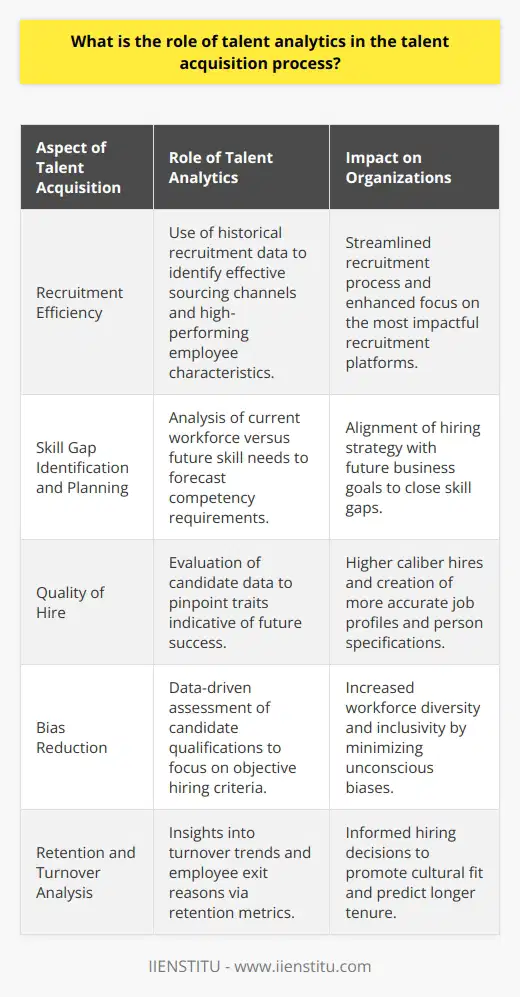
How do talent acquisition professionals utilize employer branding strategies to attract top candidates?
Employer Branding in Talent Acquisition
Employer branding plays a crucial role in attracting top candidates towards an organization. Talent acquisition professionals use different strategies to develop and showcase the employer brand, which reflects the organization's culture, values, and unique selling points.
Understanding Employee Value Proposition (EVP)
Firstly, talent acquisition professionals should understand the Employee Value Proposition or EVP, which encompasses everything that employees receive, like salary, benefits, and career growth opportunities. They should aim to showcase their employer branding by presenting a strong and attractive EVP to entice top talents.
Leveraging Social Media Platforms
Secondly, these professionals use social media platforms like LinkedIn, Twitter, and even Instagram to project employer brand. Through these channels, they share the organization's culture, employee experiences, and accomplishments to target desirable candidates actively.
Capitalizing on Employee Testimonials
Employee testimonials are another vital tool used by talent acquisition professionals to highlight the organization's culture and employee satisfaction. Top candidates often value the perspectives of current employees, and sharing these narratives creates a positive image of the company.
Aligning with Corporate Social Responsibility (CSR)
Incorporating Corporate Social Responsibility initiatives in the employer brand is another effective strategy. Organizations that engage in CSR activities can create a sense of pride and satisfaction for employees. Talent acquisition professionals can leverage this to attract like-minded candidates who prioritize social and environmental responsibility.
Employer Recognition and Awards
Lastly, showcasing employer recognition and awards can strengthen the employer brand by validating its reputation in the market. Talent acquisition professionals should actively share any accolades that speak of the organization's employee-friendly practices and overall success.
In conclusion, talent acquisition professionals use employer branding strategies to present a positive image of the organization and attract top candidates. By understanding the EVP, leveraging social media, utilizing employee testimonials, aligning with CSR initiatives, and showcasing recognition and awards, they can create a strong employer brand that appeals to the best talents in the industry.
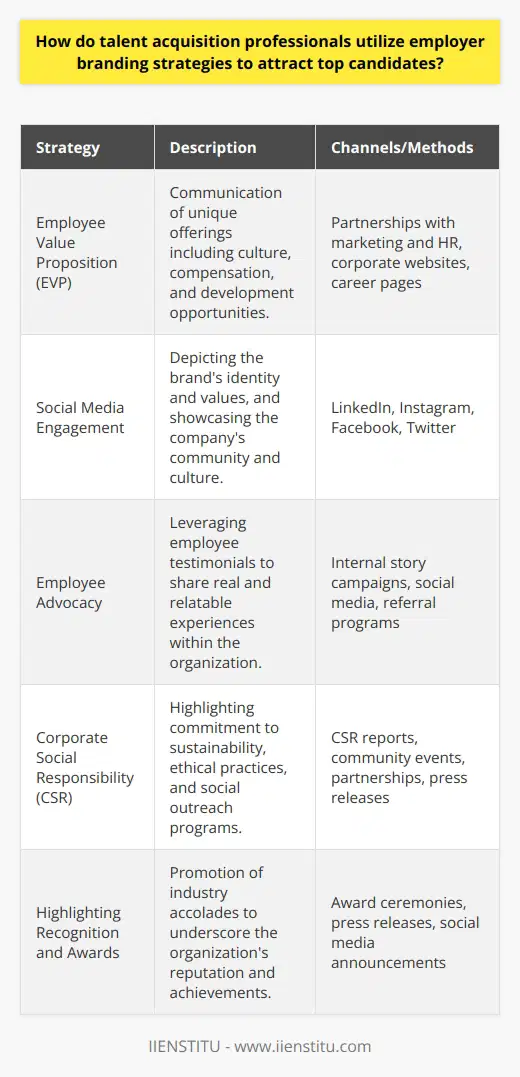
How do diversity and inclusion initiatives impact the talent acquisition process in HR?
Diversity and Inclusion Impact on Talent Acquisition
Diversity and inclusion (D&I) initiatives have gained significant importance for modern organizations. These initiatives shape the talent acquisition process in human resources (HR) and ensure that companies benefit from a wide range of talent.
Evolving Global Workforce
Globalization and technological advancements have led to borderless economies. A diverse workforce is essential to success in this competitive context. D&I initiatives help HR departments navigate multicultural environments, finding candidates with unique skill sets and perspectives.
Widening Talent Pools
D&I initiatives encourage recruiters to consider underrepresented populations during the hiring process. This practice results in broader talent pools, which contribute to improved decision-making, increased creativity, and enhanced problem-solving in the workplace.
Reducing Bias in Recruitment
Lean areas of talent acquisition to implement D&I initiatives include job postings, interviews, and selection criteria. This action ensures that recruitment activities are free from bias and based on objective measures, attracting a broader range of applicants.
Positive Employer Branding
D&I initiatives contribute to a positive employer brand, which attracts top talent to the organization. Studies indicate that job seekers prioritize companies committed to diversity and inclusion. Thus, such initiatives work as a tool to satisfy the current market demand for inclusive work environments.
Enhancing Retention and Engagement
A diverse and inclusive workplace tends to have higher employee retention and engagement rates. When employees feel valued and included, they are more motivated and committed to the organization's mission. This positive impact on employee engagement and retention ultimately leads to reduced talent acquisition costs.
In summary, diversity and inclusion initiatives play a vital role in shaping the talent acquisition process in HR. A strong emphasis on D&I attracts a broad range of candidates, contributes to a positive employer brand, and enhances employee retention and engagement, ultimately leading to organizational success. As the world becomes more interconnected, it is essential for companies to adopt such initiatives to remain competitive and relevant in the marketplace.

What is talent acquisition in HR recruiter?
Talent Acquisition in HR Recruitment
Definition and Importance
Talent acquisition is a strategic approach in human resource recruitment, focusing on attracting, identifying, and hiring skilled and talented individuals who can contribute to an organization's long-term success. This process goes beyond merely filling job vacancies. It involves understanding the company's unique needs, goals, and culture to find the right fit for both the candidate and the organization.
Attracting Top Talent
Recruiters play a crucial role in the talent acquisition process. They promote the employer brand, create a strong online presence, and develop a compelling and attractive value proposition to draw top talent to the organization. This may involve leveraging social media platforms, job portals, and professional networks to source potential candidates and build a robust talent pipeline.
Candidate Screening and Assessment
The talent acquisition process further incorporates effective candidate screening and assessment methods. These include reviewing resumes, conducting background checks, and administering online assessments to evaluate a candidate's skills, competencies, and cultural fit. A comprehensive approach ensures that recruiters only shortlist the most qualified and suitable candidates for the next stages of the recruitment process.
Interviews and Selection
Once the most suitable candidates are shortlisted, they undergo a series of interviews with the hiring team to assess their interpersonal skills, problem-solving abilities, and team fit in greater detail. This step is crucial in determining a candidate's aptitude to contribute positively to the organization. After the interviews, the recruiter makes the final selection and extends a job offer, negotiating, and finalizing the terms of employment.
Onboarding and Retention
The talent acquisition process does not end with a successful hire. Ensuring a smooth and comprehensive onboarding process is essential, as it helps new employees feel welcomed, provides them with the necessary information, and sets clear expectations. Investing in the ongoing development and engagement of employees is also vital for retaining top talent, contributing to the organization's long-term success.
In conclusion, talent acquisition is an indispensable component of an effective HR recruitment strategy. It involves attracting, identifying, evaluating, and onboarding the best individuals to contribute to the growth and success of an organization. Stitching together a seamless and efficient process is crucial to fostering a positive employer brand and retaining top talent.
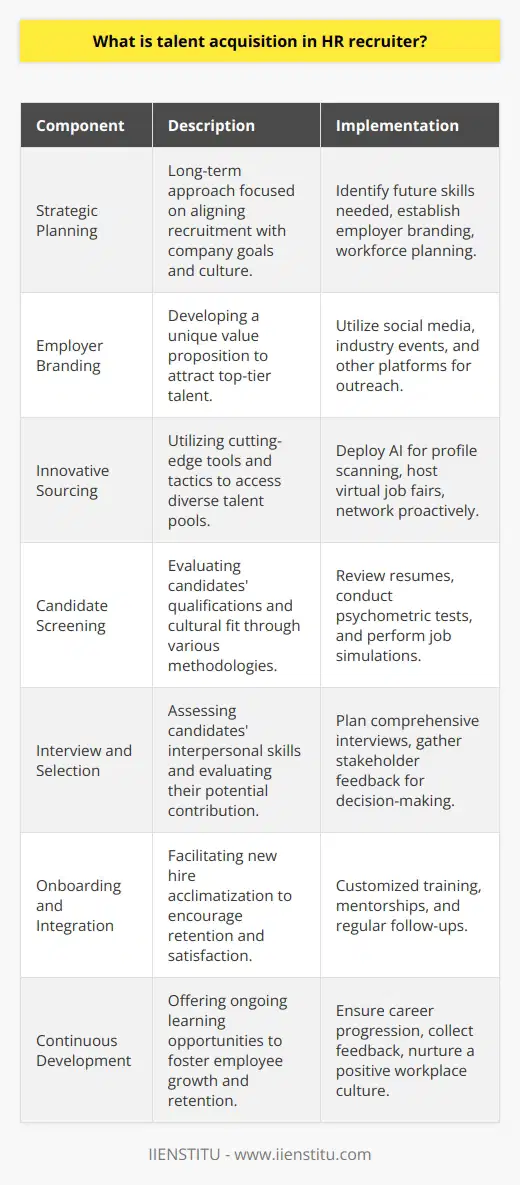
What role do competency frameworks and assessments play in the talent acquisition and development processes?
Role of Competency Frameworks
Competency frameworks play a crucial role in talent acquisition and development processes by providing a clear structure to aid in the identification of the necessary skills, knowledge, and behaviors required for success in a particular position. They offer a systematic approach for organizations to understand and define the capabilities needed for various roles, thus facilitating the standardization of expectations across the company.
Impact on Talent Acquisition
In the talent acquisition phase, competency frameworks help improve the effectiveness and efficiency of the recruitment process through the provision of role-specific criteria that can serve as a basis for job descriptions, advertisements, and interview questions. Consequently, this approach allows recruiters to screen and select candidates based on their potential to perform in a particular role, thereby reducing the probability of mismatches between the job requirements and the applicant's competencies.
Influence on Talent Development
Additionally, competency frameworks assist in talent development by providing employees and their managers with a roadmap for personal and professional growth. They enable organizations to establish a shared understanding of the expectations and proficiency levels for each role, which can be utilized to design targeted training and development programs, as well as performance management systems.
Benefits of Assessments in the Process
Assessments serve as an essential tool in both the talent acquisition and development processes by gathering information on an individual's competencies in relation to the requirements of a specific role. In the recruitment phase, assessments can be employed to evaluate a candidate's skills, knowledge, and behavioral attributes and compare them to the desired competencies for the position.
Moreover, assessments are invaluable in talent development, as they aid in the identification of strengths, weakness, and areas for improvement. Regular assessments enable employees and managers to monitor progress towards achieving the desired competency levels and customize development plans accordingly.
In conclusion, competency frameworks and assessments play an integral role in the talent acquisition and development processes by providing a systematic and data-driven approach towards identifying, selecting, and developing individuals who possess the required skills, knowledge, and behaviors for success in various roles. Implementing such frameworks and assessments can enhance the overall effectiveness and efficiency of recruitment and talent management efforts, leading to better organizational performance.
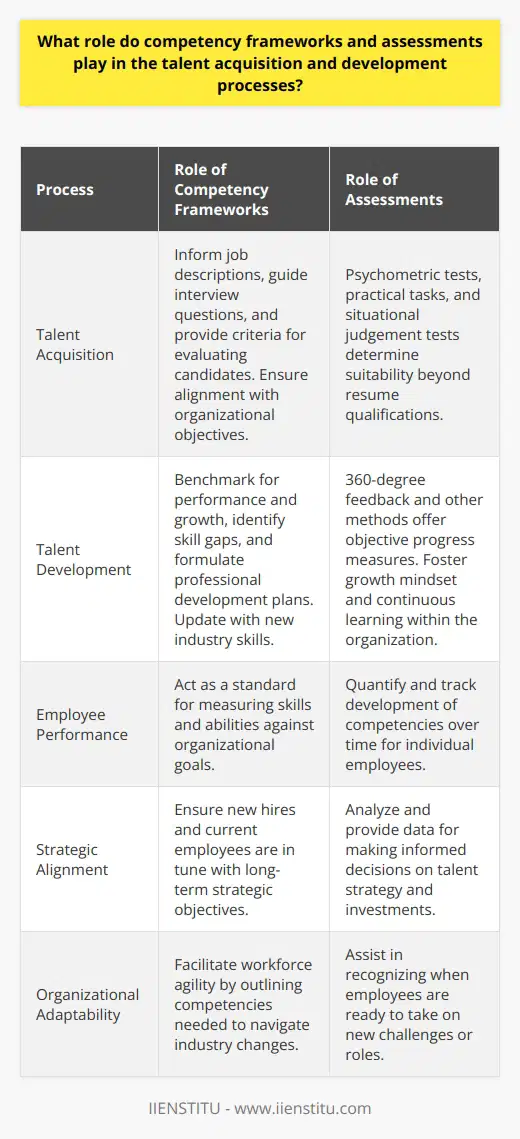
How do HR recruiters utilize technology and digital platforms to effectively identify and engage potential candidates in the talent acquisition process?
Utilizing Technology for Talent Acquisition
For HR recruiters, identifying and engaging potential candidates involves leveraging technology and digital platforms to streamline the talent acquisition process. This enhances efficiency, accuracy, and reduces time spent in traditional methods of candidate sourcing and engagement.
Innovations in Technology for Recruitment
One of the ways HR recruiters harness technology is by employing applicant tracking systems (ATS) in candidate sourcing. ATS helps in filtering the applications, making it easier for recruiters to identify prospective candidates that meet the job requirements. Additionally, data analytics and artificial intelligence (AI) tools support the recruitment process by analyzing large volumes of candidate data to determine potential matches effectively.
Digital Platforms for Candidate Engagement
Recruiters often use professional networking sites, such as LinkedIn, to engage potential candidates actively. These platforms provide access to a vast pool of professionals, where recruiters can scout for talent and engage with candidates based on their professional experiences and recommendations. Furthermore, social media channels, such as Facebook and Twitter, enable recruiters to tap into diverse talent pools and share job postings, fostering a broader candidate reach.
Use of Virtual Recruitment Methods
The incorporation of virtual recruitment methods, such as video interviews and online assessments, allows HR recruiters to engage and evaluate potential candidates more effectively. These methods not only reduce scheduling conflicts but also enable recruiters to assess a candidate's technical and interpersonal skills remotely, leading to a more accurate portrayal of the candidate's suitability for the role.
Enhancing Communication with Candidates
Utilizing technology also improves communication and interaction with potential candidates throughout the recruitment process. HR recruiters can employ email automation tools and chatbots to manage and respond to large volumes of inquiries from candidates. This optimizes the candidate experience and helps maintain an ongoing connection with prospective employees.
In conclusion, HR recruiters benefit from the use of technology and digital platforms in their quest to effectively identify and engage potential candidates in the talent acquisition process. Embracing digital innovations and tools simplifies the recruitment process, saving time and resources while ensuring a comprehensive and efficient approach to candidate sourcing and engagement.

What is the difference between HR recruiter and talent acquisition?
Role Distinction
The distinction between an HR recruiter and talent acquisition professional lies in their individual strategic approaches, objectives, and responsibilities within an organization. In essence, an HR recruiter's primary function is to fill established vacancies within a predefined timeframe, whereas talent acquisition specialists focus on adopting a long-term, strategic approach to acquiring the optimal candidates with the potential of future value.
Recruitment Process
HR recruiters concentrate on the recruitment process, which includes advertising job openings, screening resumes, conducting interviews, and ultimately extending job offers to candidates. Their objective is to minimize the time it takes to fill vacant job positions and ensure the candidates possess the necessary skills and qualifications to contribute to the company immediately.
Relationship Building
Meanwhile, talent acquisition professionals create a network of strong relationships with potential candidates, even in the absence of immediate job openings. Their approach encompasses broader organizational needs, encompassing multiple disciplines and various roles to maintain a flexible talent pipeline. This proactive workforce planning allows companies to adjust to shifting industry demands and emerging business challenges.
Talent Strategy
The talent strategy of a talent acquisition specialist delves deeper into the candidate's long-term potential within the organization and how they might contribute to the company's future success. This consideration goes beyond merely filling a specific position, as the specialist evaluates how the individual's abilities align with both current and future strategic goals.
Employer Branding
Another critical difference between the two roles is the emphasis talent acquisition professionals place on employer branding. They work to cultivate a strong employer brand, promoting the company's values, culture, and work environment, which can significantly influence a candidate's decision to join or remain with the company.
In conclusion, the primary difference between an HR recruiter and a talent acquisition professional lies in their strategic approach to meeting an organization's workforce needs. Recruiters focus on immediate vacancies, while talent acquisition specialists adopt a long-term, proactive approach, emphasizing the candidate's potential contributions to the company's future success.
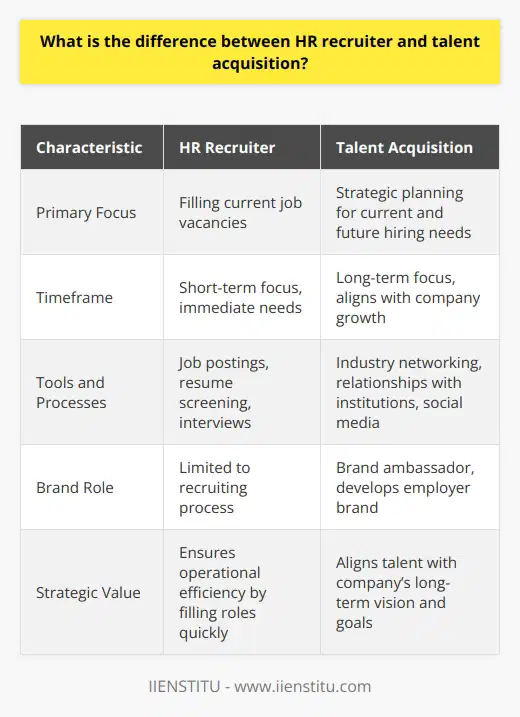
How does HR manage talent?
Talent Management Strategies
To effectively manage talent, Human Resources (HR) adopts various strategies aimed at attracting, retaining, and developing employees. This process begins with recruitment, where HR identifies essential qualifications, and engages in targeted recruitment efforts to attract individuals with the desired skill sets.
Selection and Onboarding
Once potential candidates are identified, HR plays a crucial role in the selection process. They assess applicants' suitability for the roles through various selection methods, such as interviews and aptitude tests. When successful candidates are selected, HR manages the onboarding process to ensure newcomers are integrated into the organization, fully informed about their responsibilities, and provided with opportunities for professional development.
Performance Management
HR also oversees the performance management system, which evaluates employees' progress and contributions to the organization. This entails setting performance goals, tracking achievements, and providing feedback to ensure employees understand their objectives and stay motivated. Performance evaluations create a two-way communication process between employees and supervisors, crucial for fostering an environment of continuous improvement.
Training and Development
One of the primary ways HR manages talent is through investing in employees' growth and development. HR identifies skill gaps within the organization and organizes training programs to ensure employees acquire the necessary skills to excel in their roles. Furthermore, HR encourages personal development by providing support for employees' career progression, including external training, mentoring, and opportunities for job rotation.
Recognition and Reward
Effective talent management requires recognizing and rewarding employees for their hard work and achievements. HR designs and implements incentive systems that align with organizational goals and reinforce desired employee behavior. By acknowledging employees' accomplishments and offering competitive compensation packages, HR helps to enhance job satisfaction and employee retention.
Succession Planning
Lastly, HR is responsible for succession planning, which identifies and prepares high-potential employees for leadership positions. This process enables organizations to ensure a steady pipeline of skilled and competent individuals who can take on responsibility when required. To achieve this, HR develops talent pools and creates comprehensive career development plans for promising employees.
In conclusion, HR plays a pivotal role in managing talent by implementing a range of strategies that span the entire employee lifecycle. From recruitment to succession planning, HR is instrumental in fostering a well-equipped and engaged workforce that continually evolves and adapts to the organization's needs.
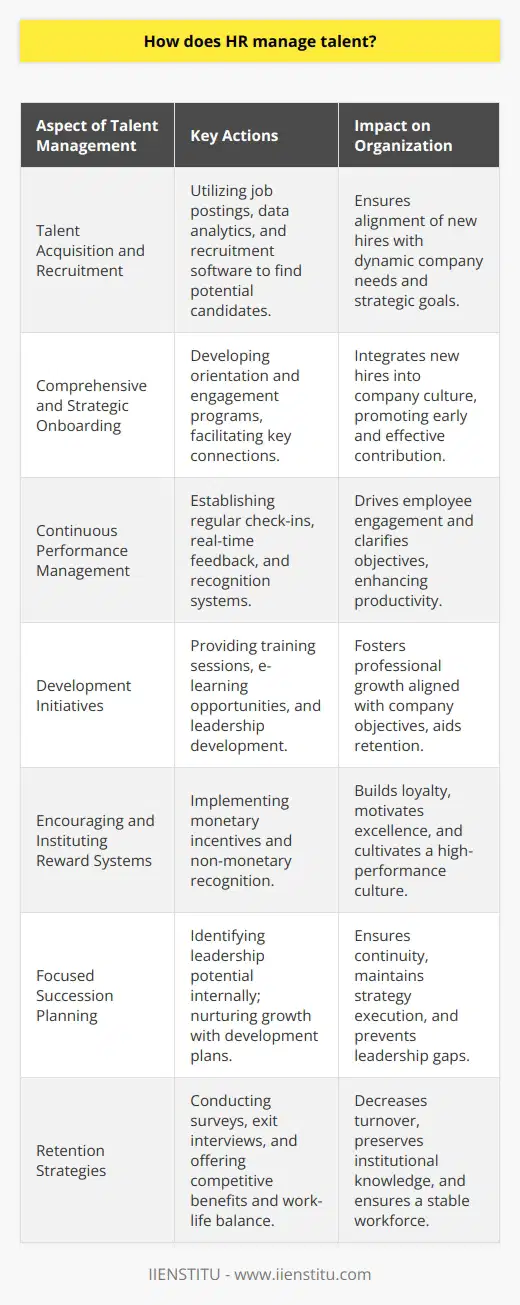
How can HR attract talent?
Attracting Top Talent
Human Resources departments can implement a variety of strategies to attract the most talented candidates in the job market. Key approaches include competitive compensation packages, strong employer branding, and flexible work arrangements.
Competitive Compensation Packages
One of the most significant factors for attracting top talent is offering a competitive compensation package. This includes not only a competitive salary but also additional benefits such as health insurance, retirement plans, and performance-based bonuses. Companies that provide comprehensive compensation packages are more likely to attract and retain high-quality candidates.
Strong Employer Branding
Having a strong and positive employer brand is essential for attracting talented individuals. A strong employer brand showcases the company's values, culture, and commitment to employee development. It communicates the company's reputation as a desirable place to work. Companies can enhance their employer brand through marketing efforts, including utilizing their website, social media channels, and employer review sites. Highlighting the company's successes, awards, and employee testimonials also contribute to building a strong employer brand.
Flexible Work Arrangements
Offering flexible work arrangements, such as remote work options, flexible schedules, and a healthy work-life balance, is a highly appealing aspect for many job seekers. Companies that provide such options demonstrate an understanding of employees' needs and a commitment to promoting a satisfying work environment. This flexibility can be a significant factor in attracting top talent, particularly in industries with increasing competition for skilled employees.
In conclusion, several key factors contribute to HR's ability to attract top talent, including competitive compensation packages, strong employer branding, and flexible work arrangements. By implementing and promoting these strategies, companies can effectively attract and retain high-quality candidates in an increasingly competitive job market.

What is the impact of effective talent recruitment on employee engagement and retention in HR?
Effective Talent Recruitment’s Impact on Employee Engagement and Retention
Talent recruitment shapes the overall strength and longevity of an organization. Effective talent recruitment can boost both employee engagement and employee retention. When human resources (HR) emphasizes suitable recruitment, they fit the job and organizational culture.
Boosting Employee Engagement
First, engagement increases when employees feel their abilities align with their jobs. Effective talent recruitment ensures that new hires possess the required skills. This skill-job fit promotes satisfaction and motivates employees to fully engage with their tasks. By focusing on key abilities and potential during the recruitment process, HR can effectively enhance overall engagement.
Enhancing Employee Retention
Employee retention also improves with effective talent recruitment. Comprehensive and thoughtful recruitment processes minimize mismatched appointments. When Employees initiate work feeling competent and well-suited for their roles, the probability of early turnover decreases. Furthermore, it saves an organization the cost of lost productivity, overtime, and training and development for replacement employees.
Streamlining the Overall HR Process
The synchronization between job profiles and employees’ characteristics also facilitates other HR processes. Performance management, training and development, and succession planning become smoother when employees align well with their roles. Consequently, organizations can operate more efficiently, contributing to their long-term success.
In sum, effective talent recruitment in HR noticeably impacts both employee engagement and retention. Organizations should invest significant effort to refine their recruitment processes. Doing so can improve their overall operations, contributing to their progress and profitability.
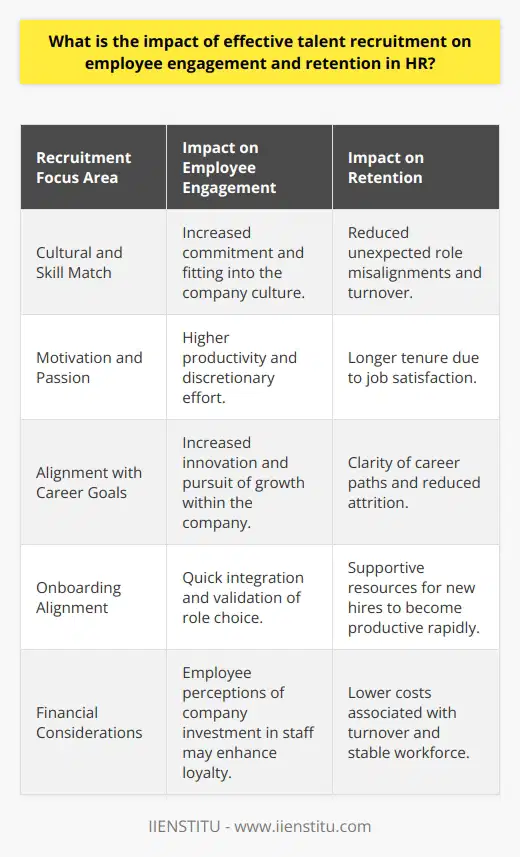
How can HR professionals balance the need for both internal and external talent acquisition to support organizational growth?
Balancing Internal and External Talent Acquisition
HR professionals must act strategically to balance internal and external talent acquisition, crucial to organizational growth. Understanding the unique benefits of each approach assists in developing a balanced strategy.
Investing in Internal Talent
Up-skilling and promoting internal talent offers several advantages. These include building employee loyalty, saving on costly hiring procedures and leveraging existing organizational knowledge. HR professionals should identify skill gaps, provide opportunities for growth and establish robust succession planning. Implementing internal mentoring programs and providing on-going learning opportunities boosts internal talent.
Attracting External Talent
External hiring brings fresh perspectives and diversified skills, sparking innovation and overcoming potential stagnation. For roles requiring niche skills or industry experience, external hiring may yield more qualified candidates. External acquisition should not be random. HR must clearly define the roles and skillsets needed, market the organization effectively and set realistic expectations to attract suitable applicants.
Promoting Diversity and Inclusion
Balancing both talent acquisition approaches also promotes diversity and inclusion. A diverse workforce, comprising of varying skill sets, experiences and perspectives, drives innovation and performance. HR professionals should ensure that hiring practices are inclusive, tapping into a wider talent pool.
Utilizing Technology
Tech tools can aid in balancing talent acquisition. HR can use analytics to forecast workforce needs, identify skill gaps and hiring trends. ATS can streamline the hiring process for external candidates, while LMS enhances internal talent development efforts.
In conclusion, HR professionals can support organizational growth by effectively balancing internal and external talent acquisition. This involves investing in the professional development of employees, targeted external hiring, promoting diversity and leveraging technology.

What strategies can be employed by HR departments to enhance the candidate experience during the talent acquisition process?
Strategic Communication
HR departments can improve the candidate experience in talent acquisition by ensuring clear, transparent, and consistent communication. By keeping candidates informed about the recruitment process's progress and decisions, HR can reduce anxiety and cultivate positive perceptions towards the organization.
Perception of Fairness
A perception of fairness in the process plays a significant role in enhancing the candidate experience. By ensuring a well-structured and unbiased interview process, HR can create a favorable impression about the firm's culture and practices, contributing positively to the candidate experience.
Feedback Mechanisms
Providing candidates with specific, constructive feedback adds immense value, especially when a candidate isn't chosen. Although time-consuming, this step is an investment in building your company's reputation and demonstrating your commitment to prospective employees.
Technological Tools
The use of technology can drastically improve the talent acquisition process. HR departments can adopt applicant tracking systems and chatbots for effective communication, scheduling, and feedback. This decreases waiting time and streamlines the entire process, leading to a positive candidate experience.
Candidate-centric Approach
Lastly, fostering a candidate-centric approach, whereby the HR focuses on the needs, expectations, and convenience of the candidate at each stage of the hiring process, can improve the overall candidate experience. This may involve flexible interview schedules, concise job descriptions, and responsive HR representatives.
In conclusion, HR departments can enhance the candidate experience by implementing clear communication strategies, facilitating a fair interview process, providing constructive feedback, incorporating technology, and embracing a candidate-centric approach. These strategies will not only improve the candidate experience but also shape the candidates' perception of the organization as a potential workplace.



